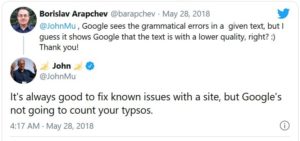How to Properly Write Website Content

SlyFox makes websites that represent small businesses, and we want to represent them as well as possible. This includes everything we write! If the content is too sloppy or confusing, it will reflect poorly on your brand.
Writing proper website content can take some getting used to, but these five tips can help make it easier!
Know your purpose and audience
Before drafting any content, ask yourself this: who is the primary audience, and what do they need to know? If the content answers their questions, you’ll be closer to clinching the conversion. If the writing is unrelated to their needs, though, your visitors will quickly lose interest.
A keyword strategy is very helpful in these instances, and you can use it to determine what your audience is searching for on Google. When you have this answer, you can write content that is most relevant to your potential audience.
Structure your content to catch attention
Long essays can be great for certain audiences, but the average internet user has a short attention span. Don’t worry, we all have this problem – and good web content capitalizes on it.
One tactic is to front-load the content with the most relevant, important information up top. In journalism, this is called the “inverted pyramid” model of writing. You can also break up the content with subheadings, letting the visitor scan the piece for relevant information. The write heading element is also very attractive to Google’s algorithms.
Another way to make your content more relevant is to use a bulleted list. Use it to break down information in a way that helps the reader identify what you want them to know:
- Don’t write points longer than two sentences.
- Keep the list consistent: if your points are sentences, make them must be all sentences; if they are single words, they should all single words.
- Don’t use nested lists.
- These are “lists within lists.”
- Nested lists break up the flow, making it harder to scan.
If the list is on the home page, keep it simple and to the point; readers can get more in-depth information on the product or service pages.
Write with short, active sentences
Write like Ernest Hemingway and keep your sentences short and active. This is writing for the online attention span – today’s reader favours sentences of 35 words or fewer.
Using active rather than passive verbs and specifying the subject of the sentence will engage your audience. Most straightforward sentences have two parts: a subject (the noun) and a predicate (the verb). When writing in the active voice, the subject of your sentence performs the action of the verb, which is easier to read. When you write in the passive voice, the main verb is performed by the subject.
For example, write “Rusty ordered the coffee” rather than “the coffee was ordered by Rusty.” If you have trouble picking out these instances in your writing, our next point is for you!
Use an outside editor for your content
Even if your properly-structured content is relevant to your audience, spelling errors and grammar mistakes can hurt its legitimacy. Google’s Webmaster Trends Analyst John Mueller said that the search engine doesn’t count typos against a site (or as he put it, “typsos”), but your audience might. Proper spelling and grammar make you look more professional, and they’ll take you more seriously as a business they can trust.

Before uploading any written content, run it through a free online editing program. Even the best writer needs a good editor, and these programs can catch the errors you might miss!
Add the right multimedia
You can enhance well-written content with original multimedia. Relevant videos, photographs, and animated graphics grab attention and encourage visitors to find out more about your products and services.
Visitors can process visual information much faster than the written word – according to recent research, 60,000 times faster! If you have a lot of numbers or complicated information, think about how you can make this easier to digest. A chart or graph can better explain a complex topic than text alone!